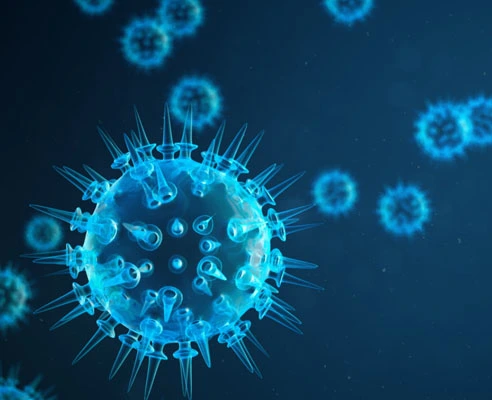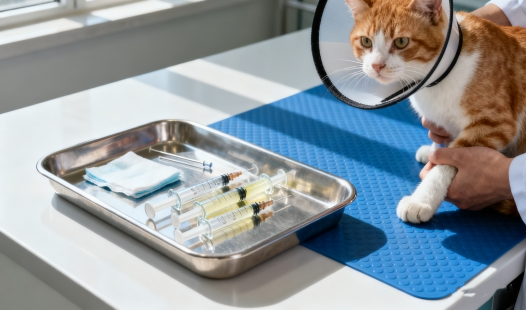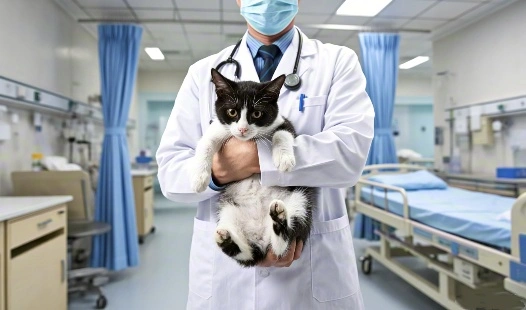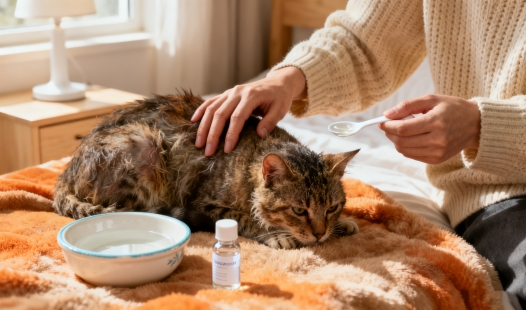Can vaccinated cats still get FIP? Understanding the limits of prevention
Mechanisms of Action and Limitations of Current FCoV/FIP Vaccines
- Mechanisms of Action and Limitations of Current FCoV/FIP Vaccines
- Documented Cases of FIP in Vaccinated Cats and Potential Explanations
- The Place of Vaccination within a Broader FIP Risk Mitigation Strategy that Includes GS-441524 Awareness
- Evaluating Vaccine Efficacy in the Context of Field Strain Variability
- Future Directions for FIP Prophylaxis and the Role of GS-441524 in Outbreak Management
- Conclusion
- FAQ
- GS-441524: A Breakthrough in FIP Management from BLOOM TECH
- References
It's been a worry for cat owners and vets for a long time that Feline Infectious Peritonitis (FIP) would spread. Vaccinations have been a key way to keep diseases away in veterinary medicine, but FIP has some problems that aren't found in other illnesses. We know a lot about the FIP vaccine and how well it works and what it can't do. This article goes into detail about how new treatments like the GS-441524 drug can help deal with this ongoing health threat to cats. The GS-441524 drug represents a promising breakthrough in FIP treatment, offering hope to cats suffering from this previously fatal disease.



Mechanisms of Action and Limitations of Current FCoV/FIP Vaccines
The development of vaccines against Feline Coronavirus (FCoV), the precursor to FIP, has been a focus of research for decades. Current vaccines aim to stimulate the feline immune system to produce antibodies against FCoV, theoretically preventing the virus from mutating into the more virulent form that causes FIP. However, the mechanisms of these vaccines face several limitations:

Strain Specificity
FCoV exhibits significant genetic variability, with multiple strains circulating in feline populations. Most vaccines target specific strains, potentially leaving cats vulnerable to others. This strain specificity limits the breadth of protection offered by current vaccines.
Immune-Mediated Enhancement
Paradoxically, some studies have suggested that FCoV vaccination might, in certain cases, enhance the likelihood of FIP development through a phenomenon known as antibody-dependent enhancement (ADE). This occurs when vaccine-induced antibodies facilitate viral entry into host cells rather than neutralizing the virus.
Mucosal Immunity Challenges
FCoV primarily infects the intestinal tract, requiring a robust mucosal immune response for effective protection. Many current vaccines, administered parenterally, may not induce sufficient mucosal immunity to prevent initial FCoV infection.
Duration of Immunity
The longevity of vaccine-induced protection against FCoV remains unclear, with some studies indicating relatively short-lived immunity. This necessitates frequent boosters, which may not be practical or desirable for all cat owners.

Documented Cases of FIP in Vaccinated Cats and Potential Explanations
Despite vaccination efforts, cases of FIP in vaccinated cats have been documented, raising questions about vaccine efficacy and the complex nature of FIP pathogenesis. Several factors may contribute to these breakthrough infections:
Pre-existing Infection
Cats may already be infected with FCoV at the time of vaccination. In such cases, the vaccine may not be able to prevent the progression to FIP, especially if the virus has already started mutating or is present in high enough quantities in the cat’s system. The vaccine may not be as effective in stopping the disease once the virus has gained a foothold. However, treatments like the GS-441524 drug can be an effective therapeutic option to help control the disease once it begins to manifest.
Viral Mutation
The high mutation rate of coronaviruses is a significant challenge in controlling FIP. Even if a vaccine is effective against one strain of FCoV, mutations in the virus can lead to new variants that the vaccine cannot protect against. These mutated strains might possess the ability to escape immune detection, making the vaccine less effective and increasing the likelihood of FIP developing in some cats.
Individual Immune Responses
The response to vaccination can vary greatly from one cat to another. Factors such as age, overall health, genetic predisposition, and immune system strength can influence how well a cat responds to the vaccine. Older cats, kittens, or those with weakened immune systems may not develop a strong enough immune response to prevent FIP, even if they have been vaccinated.
Environmental Factors
Stress, co-infections, and other environmental factors can significantly impact a cat's immune system, potentially undermining the protective effects of the vaccine. In multi-cat households, crowded conditions, changes in routine, or the presence of other infections can trigger immune suppression, which could allow FIP to develop even in vaccinated cats. Managing the overall health of the cat's environment is crucial for maximizing the vaccine's efficacy.
The Place of Vaccination within a Broader FIP Risk Mitigation Strategy that Includes GS-441524 Awareness
While vaccination remains an important tool in feline health management, its limitations in preventing FIP necessitate a more comprehensive approach to risk mitigation. Integrating GS-441524 awareness into this strategy offers promising avenues for FIP management:
Multi-faceted Prevention
Combining vaccination with other preventive measures such as stress reduction, proper hygiene, and minimizing exposure to FCoV can significantly enhance overall protection against FIP. Educating cat owners on the importance of a holistic approach—including isolating infected cats, maintaining clean living environments, and ensuring proper nutrition—can help reduce the chances of FIP outbreaks. Integrating the GS-441524 drug as a potential therapeutic option adds an extra layer of protection in case a cat does develop the disease, offering an additional way to mitigate risk.
Early Detection and Intervention
Promoting awareness of early FIP symptoms, such as fever, lethargy, and abdominal swelling, is essential for early detection. Cats showing these signs should be quickly isolated and examined by a veterinarian. Knowing that the GS-441524 drug has shown promise in treating FIP can lead to quicker intervention, potentially improving outcomes for affected cats. Early treatment with the GS-441524 drug may reduce the severity of the disease, allowing more cats to recover or manage the condition effectively.
Targeted Vaccination Strategies
Focusing vaccination efforts on high-risk populations, such as cats in multi-cat households or shelters or those with compromised immune systems, may optimize the use of current vaccines. Since these environments provide more opportunities for FCoV transmission, targeted vaccination can be more effective in reducing the spread of the virus. Meanwhile, as research continues on more effective formulations, incorporating antiviral treatments like the GS-441524 drug into care protocols for high-risk cats can provide a safety net against FIP.
|
|
|
|
Evaluating Vaccine Efficacy in the Context of Field Strain Variability
The effectiveness of FCoV/FIP vaccines must be continually assessed against the backdrop of evolving viral strains in real-world settings:

Surveillance Programs
Implementing robust surveillance programs to monitor circulating FCoV strains is crucial for guiding vaccine development. By tracking the prevalence and mutation patterns of different strains in various regions, researchers can better understand which variants are circulating and whether current vaccines provide adequate protection. Surveillance data can help identify potential gaps in vaccine coverage and inform decisions for future formulations.
Challenge Studies
Conducting carefully designed challenge studies with diverse FCoV strains can provide valuable insights into vaccine efficacy. These studies simulate natural exposure to the virus, allowing researchers to assess how well the vaccine performs against various strains. The results can highlight the strengths and limitations of existing vaccines and identify areas where improvements are necessary, particularly in response to viral mutations.


Field Trials
Large-scale field trials in diverse feline populations, including multi-cat households, shelters, and different geographic regions, offer a more comprehensive understanding of vaccine performance under real-world conditions. These trials can reveal how the vaccine holds up against the environmental factors and stressors that cats face in everyday life, as well as its long-term effectiveness. Insights from field trials can guide adjustments to vaccination protocols and improve overall vaccine strategy.
Future Directions for FIP Prophylaxis and the Role of GS-441524 in Outbreak Management
As research into FIP prevention and treatment continues, several promising avenues emerge:
Novel Vaccine Technologies
Exploring new vaccine platforms, such as mRNA vaccines or vectored vaccines, could revolutionize FIP prevention. These innovative approaches offer the potential for more targeted immune responses and broader protection against the virus. By utilizing cutting-edge technology, such vaccines might be able to address the high mutation rate of FCoV, providing more lasting immunity and potentially preventing the progression of FIP in more cats. While vaccines are essential, the GS-441524 drug is also being investigated as a crucial treatment option for cats that do develop FIP, complementing vaccination efforts.
Combination Therapies
Investigating the potential synergy between vaccination and antiviral treatments like GS-441524 is an exciting direction for FIP management. By combining the immune-boosting properties of vaccines with the antiviral power of drugs like GS-441524, researchers hope to offer more comprehensive protection. This dual approach could not only help prevent FIP but also provide effective treatment for cats that may still develop the disease, improving outcomes and survival rates.
Genetic Resistance
Studying genetic factors that confer natural resistance to FIP is another promising area of research. Identifying specific genes or traits that help some cats resist FIP could lead to new breeding strategies aimed at strengthening the feline immune system. In addition, genetic research may open the door to gene therapy approaches that could enhance natural immunity, offering a long-term solution for reducing the prevalence of FIP in future generations of cats.
Conclusion
While vaccination remains an important tool in the fight against feline infectious diseases, its efficacy in preventing FIP is limited by the complex nature of the virus and the disease process. Current vaccines may offer some protection, but vaccinated cats can still develop FIP due to various factors including viral mutation, individual immune responses, and environmental stressors.
A comprehensive approach to FIP prevention and management is essential, incorporating vaccination alongside other preventive measures, early detection strategies, and awareness of emerging treatments like GS-441524. As research continues, the integration of novel vaccine technologies, combination therapies, and genetic approaches may lead to more effective FIP prophylaxis in the future.
Cat owners and veterinarians must remain vigilant, even with vaccinated cats, and be prepared to respond quickly to signs of FIP. The ongoing development of treatments like GS-441524 offers hope for improved outcomes in FIP cases, highlighting the importance of a multi-faceted approach to feline health management.
FAQ
1. Can a vaccinated cat still contract FIP?
Yes, vaccinated cats can still develop FIP. While vaccines may offer some protection, they are not 100% effective due to viral mutation, individual immune responses, and other factors.
2. How often should cats be vaccinated against FCoV to maintain protection?
The optimal vaccination schedule for FCoV is still under research. Current recommendations vary, but annual boosters are often suggested. Consult with your veterinarian for personalized advice based on your cat's risk factors.
3. Is GS-441524 a replacement for FIP vaccination?
No, GS-441524 is not a replacement for vaccination. It is a treatment for cats diagnosed with FIP, while vaccines aim to prevent infection. Both have roles in managing FIP, but they serve different purposes in feline health care.
GS-441524: A Breakthrough in FIP Management from BLOOM TECH
We know at BLOOM TECH how important it is for cats' health to stop FIP. The high quality of our GS-441524 product is a big step forward in fip treatment. It helps cat owners and vets who are dealing with this tough disease. BLOOM TECH is on the cutting edge of FIP management because we have strict quality control measures and only use methods that have been proven to work. For inquiries about our GS-441524 product or to discuss how we can support your veterinary practice, please contact us at Sales@bloomtechz.com. Trust BLOOM TECH for your GS-441524 manufacturer needs.
References
1. Pedersen, N. C. (2019). Feline infectious peritonitis: A review of the current state of knowledge. Journal of Feline Medicine and Surgery, 21(3), 201-220.
2. Addie, D. D., & Jarrett, O. (2006). Feline coronavirus infections. In C. E. Greene (Ed.), Infectious diseases of the dog and cat (3rd ed., pp. 88-102). Saunders Elsevier.
3. Drechsler, Y., Alcaraz, A., Bossong, F. J., Collisson, E. W., & Diniz, P. P. (2011). Feline coronavirus in multicat environments. Veterinary Clinics of North America: Small Animal Practice, 41(6), 1133-1169.
4. Murphy, B. G., Perron, M., Murakami, E., Bauer, K., Park, Y., Eckstrand, C., Liepnieks, M., & Pedersen, N. C. (2018). The nucleoside analog GS-441524 strongly inhibits feline infectious peritonitis (FIP) virus in tissue culture and experimental cat infection studies. Veterinary Microbiology, 219, 226-233.

Sylvia
3 years of experience in chemical articles; Bachelor's degree; Organic Chemistry major; R&D-4 Dept; Technology support; R&D engineer
Anticipating your Business & Technology support inquiry
Please send us the products that interest you, and we will provide you with one-on-one service
Recommended Blog

How long does it take for cats to show improvement on GS-441524?
_副本_1761791260585.webp)
What is the difference between GS 441524 injection and GS 441524 pills?






_副本_1761272616887.webp)






